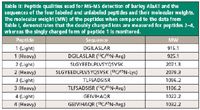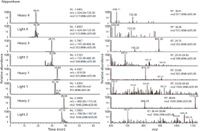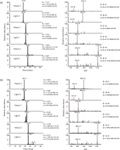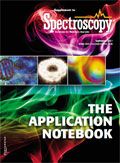A Novel Approach to Measure Crop Plant Protein Expression
Application Notebook
Crop development to improve yield or disease resistance has been explored for centuries and the technologies to measure these improvements have subsequently become complex. The use of transgenes in crop plants is a more technically advanced approach than traditional breeding and the success of this approach is best assessed using modern techniques that accurately quantify the desired traits. Here, we applied targeted liquid chromatography–mass spectrometry (LC–MS) using synthetic stable isotope–labeled peptides to identify and quantify the relative levels of transgenic to native protein.
Crop development to improve yield or disease resistance has been explored for centuries and the technologies to measure these improvements have subsequently become complex. The use of transgenes in crop plants is a more technically advanced approach than traditional breeding and the success of this approach is best assessed using modern techniques that accurately quantify the desired traits. Here, we applied targeted liquid chromatography–mass spectrometry (LC–MS) using synthetic stable isotope–labeled peptides to identify and quantify the relative levels of transgenic to native protein. The methodology was developed using rice plants in which mRNA expression and phenotypic effect of the transgene had been validated. Relative quantification of transgenic barley alanine aminotransferase (AlaAT) used targeted LC–MS of tryptic protein fragments. We chose the LC–MS method as a superior technique to directly measure protein levels because other methods such as western blot analysis and RNA were unable to distinguish the minor amino acid differences between the transgenic and native proteins. Establishment of this methodology is a first step toward using LC–MS as a predictive tool to quantify the value of genetically engineered plants before the high investment of a full field trial.
The improvement of crop plants for yield, insect resistance, and abiotic stress tolerance is a continuous process in agriculture. In addition to traditional breeding, genetic engineering offers an approach to introduce changes with a targeted adjustment in a plant's ability to grow. While the ultimate goal in crop improvement is often focused on increasing yield, the tools to measure the biological changes in the plant vary. Selecting the right tool to quantify the improvement hinges on many factors but all other things being equal, the most important consideration is the balance of time and cost.
Here we describe the use of liquid chromatography–mass spectrometry (LC–MS) to quantify the expression levels of a transgenic protein, barley alanine aminotransferase (AlaAT) across multiple rice lines. LC–MS is an increasingly popular tool in proteomic analyses because it bypasses the difficulties and time often needed for generating antibodies to detect specific proteins (1–5). LC–MS would be particularly useful when specific antibodies are not available, as is the case for barley AlaAT. The AlaAT protein superfamily is highly conserved, and currently available antibodies detect both the native and transgenic protein, thus confounding our ability to quantify the presence of the specific transgene. Therefore, LC–MS technology was selected based on its ability to accurately differentiate transgenic from native proteins.
We detected and quantified transgenic proteotypic peptides using stable isotope–labeled peptides as internal standards and spiked them into rice leaf samples to accurately quantify the endogenous levels of transgenic protein. This workflow is similar to other targeted proteomic workflows for the identification of biomarkers and low-level endogenous proteins in complex matrices (6,7).
Our goal was to measure the amount of transgenic barley AlaAT protein against the amount of native AlaAT across multiple rice lines. If the technique proves to be a robust and accurate means to measure protein levels, in the future we could apply LC–MS to evaluate the potential performance of a rice line before the investment in space, time, and resources for a field trial. By correlating yield improvements to transgenic protein levels in the greenhouse or growth chamber, we could significantly reduce the number of transformation lines that require field testing. The first step in this process is to establish the methodology with plant lines that have been evaluated in the field and determine whether LC–MS is a suitable tool for measuring protein levels. The work we describe here established the necessary resources to differentiate transgenic from native protein using LC–MS as a primary tool.
Experimental Methods
Tissue Collection
Flag leaves were collected at the booting stage from field-grown rice plants in which mRNA expression level and phenotypic effect of the transgene had been validated. The plant leaves were immediately frozen in liquid nitrogen and stored until manually ground to homogenization using a chilled mortar and pestle.
Total Protein Quantification and Normalization
Protein samples were prepared using the NucleoSpin RNA/Protein kit and quantified using the Protein Quantification Assay (both from Macherey-Nagel) according to manufacturer instruction. All protein samples were analyzed by 4–12% Bis-Tris sodium dodecyl sulfate–polyacrylamide gel electrophoresis (SDS-PAGE) in MES buffer (Invitrogen).
Protein Gel Electrophoresis
A 5-µL volume of Kaleidoscope Prestained Standard (Bio-Rad) and 70 µg of each total protein sample were loaded onto a NuPAGE Novex 4–12% Bis-Tris Gel 1.5 mm, 10-well precast polyacrylamide gel (Invitrogen). The protein bands were visualized using the Colloidal Blue Staining Kit (Invitrogen).
Excision of Barley AlaAT Protein Bands
The gel was cut into approximately 1-mm pieces for each sample between the BSA band (<78 kDa) and the carbonic anhydrase band (>45.7 kDa), a section that contains the target barley AlaAT protein. Blank lanes were used as controls. Gel pieces were stored separately at -20 °C in 1.5-mL siliconized Eppendorf tubes.
Peptides and Digest
The bands corresponding to AlaAT were excised, destained, reduced with tris (2-carboxyethyl)phosphine (TCEP), and alkylated with iodoacetamide before digestion using an in-gel tryptic digestion kit (Thermo Fisher Scientific). Quantification of AlaAT in transgenic rice used targeted LC–MS of four peptides. We previously discovered which peptides could be readily detected in the transgenic rice lines. Peptides were selected based on results from transgenic rice samples and are described in Table I. Liquid chromatography–multiple reaction monitoring-mass spectrometry (LC–MRM-MS) was used to determine which of the specific proteotypic peptides generated clear MRM signals in the endogenous matrix of background peptides. The peptides were also selected based on unique sequence identity for barley over the rice native AlaAT. Four synthetic heavy peptides (Table I, Thermo Fisher Scientific) were mixed with sequencing-grade porcine trypsin (Promega) just before its addition to excised gel pieces. Protein was digested using a protein-to-enzyme ratio of approximately 50:1 and incubated at 37 °C for 16 h. The amount of each stable isotope (13 C/15 N)–labeled peptide added to each gel sample was 1500 fmol. For each analysis, one-half of the recovered tryptic digest was analyzed.

Table I: Targeted peptides of barley alanine aminotransferase. The peptide mass filters and quantitative ions used for the detection of AlaAT in the prepared plant tissue samples for all four peptide sequences. "Light" denotes the native peptides; "heavy" denotes the peptides containing a stable isotope label at the terminal residue. Note the retention times do not shift between the labeled and unlabeled peptides, the only observed change is the quantitative ions.
Chromatography and Mass Spectrometry
Chromatography of peptides used a Paradigm MDLC MS4 LC pump and a 150 mm × 0.2 mm, 3-µm dp, 200-Å C18AQ column (Michrom Bioresources). Peptides were eluted using a 2-µL/min flow rate and a gradient of acetonitrile (solvent B) in 0.1% formic acid (solvent A) as follows: 5–40% B over 50 min, 40–80% B over 1 min, hold at 80% B for 1 min, 80–5% B over 1 min, and hold at 5% B for 14 min.
An LCQ Deca XP-plus ion-trap mass spectrometer (Thermo Scientific) equipped with a Michrom Advance Spray Source was used for MS-MS analysis in positive-ion electrospray mode. The source spray voltage was 1200 kV and the capillary temperature was 200 °C. The MS-MS filters, instrument conditions, and voltages were optimized for each targeted peptide by direct infusion and LC–MS analyses of the heavy synthetic peptides. LC–MS data were integrated and processed using Xcalibur software (Thermo Scientific).
Results
For the first iteration of barley AlaAT detection, we needed to establish a cost-effective protein separation technique that could later be applied to multiple plant lines in a moderate high-throughput manner. Proteins from all samples were extracted and purified by SDS-PAGE. While there are other ways to separate proteins in a crude extract, separation by SDS-PAGE allows for a rapid, relatively inexpensive way to process a high number of samples. The expression of transgenic barley AlaAT was expected to be low, therefore, minimizing the influence of other, more highly abundant proteins through SDS-PAGE provided a potentially reproducible approach for multiple plant lines and species. The protein bands were digested, in gel, with trypsin in the presence of synthetic heavy peptides to minimize the variables that could interfere with relative quantification.

Figure 1: Protein sequence alignment of the barley and rice AlaATs. The underlined regions of the barley sequence indicate the peptide sequences used to measure AlaAT and the names are listed above the indicated peptide. The underlined residues in the rice AlaAT sequence denote the amino acids that are different from the barley AlaAT. Note that for the first occurring peptide sequence (labeled peptide 4) is identical in barley and rice.
The next step was to select AlaAT peptides that could differentiate between native rice and transgenic barley protein. We chose four peptides that were frequently detected in LC–MS analysis for AlaAT and used stable isotope–labeled peptides to identify and measure the levels of transgenic protein in rice. Peptides 1-3 are specific to barley AlaAT and peptide 4 is present in both barley and rice AlaATs based on their known protein sequences (Figure 1). These synthetic peptides were used for quantification of barley AlaAT in the transformed rice lines using the isotopic dilution technique (8) and full-scan MS-MS detection at the expected retention times to maximize sensitivity. The MS-MS filters, instrument conditions, and voltages were optimized for each targeted peptide by direct infusion and LC–MS-MS analysis of the individual heavy synthetic peptides (Table II).

Table II: Peptide qualities used for MS-MS detection of barley AlaAT and the sequences of the four labeled and unlabeled peptides and their molecular weights. The molecular weight (MW) of the peptides when compared to the data from Table I, demonstrates that the doubly charged ions are measured for peptides 2â4, whereas the singly charged form of peptide 1 is monitored.
To establish the differentiation of barley AlaAT over native, a wild-type rice sample was extracted and spiked with synthetic peptides 1–4. The only native peptide derived from endogenous protein that was detected in this sample corresponded to peptide 4. The three remaining peptides were not detected in the wild-type rice samples. An example of the chromatogram and spectra from the wild-type Nipponbare rice sample is shown in Figure 2. The detection of peptide 4 is clear and the lack of any ions representing peptides 1–3, the three barley-specific AlaAT peptides, indicates barley AlaAT is not present.

Figure 2: Chromatograms and spectra of all four heavy peptides and one light peptide in the Nipponbare wild-type rice sample. Unlabeled ions for peptides 3, 1, and 2 were expected at 882.25, 800.23, and 798.16, respectively, but were not found at the expected retention times.
Next, we evaluated the ability of LC–MS to detect and relatively quantify the levels of barley AlaAT protein in six transgenic rice lines using the selected synthetic peptides specific to barley AlaAT. Two rice cultivars, Nipponbare and Taipei, were used to examine the potential differences in response to nitrogen stress. Four transgenic lines, two from the Nipponbare cultivar (NAAT1 and NAAT2) and two from the Taipei cultivar (TAAT3 and TAAT4) were compared to their parental wild-type (Nipponbare and Taipei) varieties grown at the same time to ensure any variation detected was because of natural differences among different transformation events. Each transgenic cultivar contained a single copy of AlaAT isolated from barley (Hordeum vulgare) as previously described (9). Though mRNA expression level and phenotypic effect of the transgene had been validated in the plants, the protein level of barley AlaAT in each of these lines is unknown.
A representative LC–MS chromatogram and spectra of all the peptides in the transgenic NAAT2 rice sample is shown in Figure 3a. The base peaks corresponding to each of the heavy and light barley AlaAT peptides have been selected. Figure 3b shows the same three peptides in the transgenic rice sample TAAT3. Each of the peptides is eluted separately and is distinguishable from other potentially interfering peptide ions as indicated by the retention times. We determined that targeting the scan methods to the specific ions from each peptide greatly increased the sensitivity over the use of data-dependent MS-MS analysis and provided a limit of detection of approximately 5 fmol per gel-purified sample. This is equivalent to about 4 ppm, based on total protein levels in the extract before SDS-PAGE purification.
The results for all six rice lines are summarized in Table III. The values represent the femtomolar amount of each peptide measured in all samples. The area under each peak of the relevant peptide was measured and calculated as a ratio of heavy to light. Based on the results of the ratio, the total amount (in femtomoles) of each peptide was reported. To calculate the approximate amounts of barley AlaAT protein in the samples, the values for peptides 1–3 were averaged and are reported as a function of the total protein loaded on the gel. While the values for peptide 4 are presented, they were not used to calculate the amount of barley AlaAT in the transgenic rice samples.

Figure 3: Representative chromatograms and spectra of the three unique barley AlaAT heavy peptides in the transgenic (a) Nipponbare (NAAT2) and (b) Taipei (TAAT3) rice samples. Unlabeled ions for peptides 1â3 were found at comparable levels in all the samples.
The measured amounts for each of the peptides in all of the samples were affected relatively similarly. That is, if a low amount of peptide 3 was found in NAAT1, it was also found to be within a similarly low range in NAAT2, TAAT3, and TAAT4. Therefore, it appears that the peptides were affected equally in each sample. The only exception was peptide 4, which was expected because this peptide detects both endogenous AlaAT and barley AlaAT. There are currently no publicly available data that measure native AlaAT in rice flag leaves.
The data indicate that barley AlaAT protein levels are relatively equal across these selected transgenic lines: NAAT1 and NAAT2 were calculated to contain 134 and 160 fmol of barley AlaAT per gram of plant leaf tissue, respectively. The low amounts of peptides 1–3 in NAAT1 clearly contributed to a reduced calculated protein value and the lowest overall. Interestingly, the peptide 4 value in NAAT1 was measured nearly as high as the Taipei wild-type sample. The Taipei transgenic lines TAAT3 and TAAT4 contained 170 and 204 fmol of barley AlaAT protein per gram of leaf tissue, respectively. Overall, the Taipei transgenic lines contained slightly more protein than the Nipponbare transgenic lines; however the difference is not significant. The slight difference could be because of the timing of the harvest. Although all the plants were harvested during the booting phase, Taipei takes slightly longer to mature and therefore the developmental stages could have been slightly different. The values for each peptide in all samples agreed with the average calculated protein levels of barley AlaAT. For example, if peptide 1 was higher in TAAT3 than NAAT1 that was also true for peptides 2 and 3. The values of peptide 4 varied the most among all the peptides, ranging from 120 to 602 fmol; however, recall that this peptide is shared between rice and barley and therefore its levels are likely skewed because of interference from the native levels of AlaAT, which could also vary among the lines and rice varieties.

Table III: Presence of AlaAT protein in transgenic and wild-type rice leaf samples. Individual amounts (fmol) of peptides from each plant sample. Transgenic NAAT1 and NAAT2 share the Oryza sativa L. Japonica Nipponbare parent. Transgenic TAAT3 and TAAT4 originate from Oryza sativa cv. Taipei. Peptide 4 is known to share sequence identity in rice and barley and the measured values are indicated, but are not included in the overall average for the transgenic lines.
Discussion
Here we provide evidence that LC–MS is useful for the quantification of a transgenic protein that has high identity (89%) with its native homolog. The sequences are merely punctuated by single amino acid differences that we believe are best observed using LC–MS. Our previous attempts to quantify AlaAT included several iterations of antibody generation and assay optimization that only resulted in a simple scale of transgene protein levels that was not quantitative because of interference from endogenous AlaAT. The amounts of barley AlaAT could only be measured relative to background (wild-type) and other transgenic lines. Moreover, barley AlaAT has the same mass as the most abundant protein in plant leaves, Rubisco, and migrates on its gel front further interfering with reliable detection. We found that using LC–MS to measure the relative levels of barley AlaAT was a reliable alternative to traditional protein detection techniques. Once peptides were identified that would work for LC–MS detection of barley AlaAT, optimization of the MS parameters for consistent and accurate detection was relatively simple and provided a way to overcome interference from other proteins such as Rubisco. Within a month, the limit of detection was established, all four peptides were producing reliable spectra, and several plant lines had been screened. The methodology has become so facile that we intend to apply the techniques to other rice lines that have not yet been evaluated in the field.
LC–MS can be subject to unpredictable matrix affects, creating difficulty in measuring specific target proteins. Here we found that even though the relative amounts of each peptide varied within a sample, the averaged values provided a way to more accurately quantify the levels of transgenic protein in rice leaf tissue.
Before the development of LC–MS, researchers relied on using antibodies to determine whether the targeted transgenic protein was present in transformed material. However, antibodies are limiting in specificity, expensive to develop, and require several months to fully develop a reliable assay. Targeted protein detection using MS reduces the total investment of time and money, while applying methodology that accurately detects the target separate from other proteins that may share similar or identical sequences that may not be discernible by older techniques.
Conducting field trials requires an extremely demanding investment of time and money and is the core of the agricultural business. Demonstrating field efficacy is paramount to the potential commercialization of a product; without clear field data, the product is not considered. Therefore, several field trials are conducted over several growing seasons, often yielding only one or two lead events that demonstrate a potential commercial product. The process can take at least 4–5 repeated trials with the single event before the data can be compounded to show the trait is working. The process of plant transformation lends itself to a range of lines with extremely low or no gene expression through high expression. In the event that protein levels can be tied to trait efficacy, LC–MS provides the ability to prescreen the transformation events in the greenhouse before investment in full field evaluation.
Conclusion
We applied targeted LC–MS using synthetic stable isotope–labeled peptides to measure the levels of transgenic barley AlaAT protein in various plant samples. LC–MS offered a unique approach to measure the transgenic protein against native protein levels. We were able to establish a methodology that can be applied to other rice transgenic events that may have different protein expression levels. The next step will be to discover the relationship between protein levels and trait efficacy and then continue to expand the methodology to other plant species. Until recently, detection of transgenic proteins mostly relied on older methodology that could not discern subtle differences in protein composition. As we continue to develop MS techniques, even more enhancements can be made to detect minor differences between molecular species and a broader application can be discovered.
Acknowledgment
The authors would like to thank Dr. Brett Phinney and Rudy Alvarado for initially establishing the detected peptides and providing helpful advice and guidance regarding proteomic analyses. We would also like to thank Dr. Margaret Miller and Dr. Ann Slade for careful reading of this manuscript.
References
(1) C.C. Wu and J.R. Yates III, Nat. Biotechnol. 21(3), 262–267 (2003).
(2) S.E. Ong and M. Mann, Nat. Chem. Biol.1(5), 252–262 (2005).
(3) U. Lehmann et al., Plant J. 55(6), 1039–4106 (2008).
(4) M. Mann, J. Proteome Res.7(8), 3065–3065 (2008).
(5) T. Fortin et al., Mol. Cell Proteomics 8(5), 1006–1015 (2009).
(6) A.K. Yocum and A.M. Chinnaiyan, Brief. Funct. Genomic. Proteomic. 8(2), 145–157 (2009).
(7) A. Prakash et al., J. Proteome Res. 8(6), 2733–2739 (2009).
(8) H.W. Lahm and H. Langen, Electrophoresis 21(11), 2105–2114 (2000).
(9) A.K. Shrawat et al., Plant Biotechnol. J. 6(7), 722–732 (2008).
Wayne Skinner, Zina Dahmani, Yingzhi Lu, Jean C. Kridl, and Gia C. Fazio are with Arcadia Biosciences, Inc., in Davis, California. Direct correspondence to: gia.fazio@arcadiabio.com.
